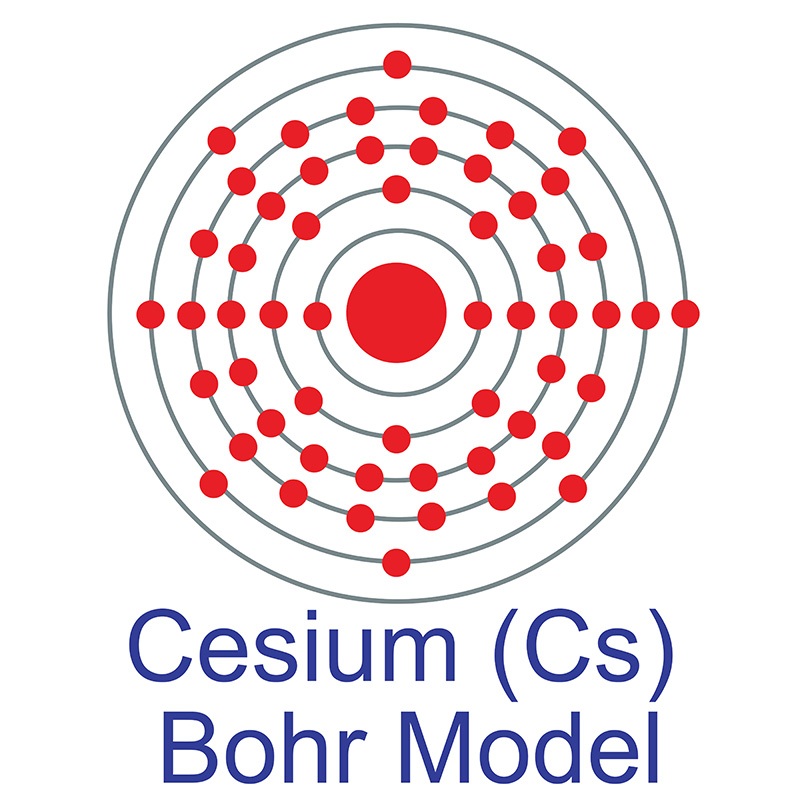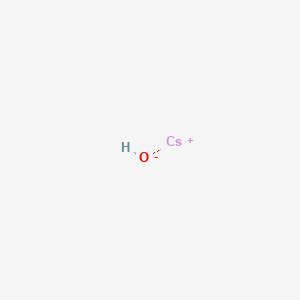SECTION 1. IDENTIFICATION
Product Name: Cesium Hydroxide Solution
Product Number: All applicable American Elements product codes, e.g. CS-OH-02-SOL
, CS-OH-03-SOL
, CS-OH-04-SOL
, CS-OH-05-SOL
CAS #: 21351-79-1
Relevant identified uses of the substance: Scientific research and development
Supplier details:
American Elements
10884 Weyburn Ave.
Los Angeles, CA 90024
Tel: +1 310-208-0551
Fax: +1 310-208-0351
Emergency telephone number:
Domestic, North America: +1 800-424-9300
International: +1 703-527-3887
SECTION 2. HAZARDS IDENTIFICATION
Classification of the substance or mixture:
GHS Classification in accordance with 29 CFR 1910 (OSHA HCS)
Acute toxicity, Oral (Category 4), H302
Skin corrosion (Category 1B), H314
Serious eye damage (Category 1), H318
Signal word: Danger
Hazard statement(s):
H302 Harmful if swallowed.
H314 Causes severe skin burns and eye damage.
H318 Causes serious eye damage.
Precautionary statement(s):
P264 Wash skin thoroughly after handling.
P270 Do not eat, drink or smoke when using this product.
P280 Wear protective gloves/ protective clothing/ eye protection/ face protection.
P301 + P312 + P330 IF SWALLOWED: Call a POISON CENTER/doctor if you feel unwell. Rinse mouth.
P301 + P330 + P331 IF SWALLOWED: Rinse mouth. Do NOT induce vomiting.
P303 + P361 + P353 IF ON SKIN (or hair): Remove/ Take off immediately all contaminated clothing. Rinse skin with water/ shower.
P304 + P340 + P310 IF INHALED: Remove victim to fresh air and keep at rest in a position
comfortable for breathing. Immediately call a POISON CENTER or doctor/ physician.
P305 + P351 + P338 + P310 IF IN EYES: Rinse cautiously with water for several minutes. Remove
contact lenses, if present and easy to do. Continue rinsing. Immediately call a POISON CENTER/doctor.
P363 Wash contaminated clothing before reuse.
P405 Store locked up.
P501 Dispose of contents/ container to an approved waste disposal plant.
Hazards not otherwise classified (HNOC) or not covered by GHS - none
SECTION 3. COMPOSITION/INFORMATION ON INGREDIENTS
Mixtures
Formula: HCsO
Molecular weight: 149.91 g/mol
CAS-No.21351-79-1
EC-No. 244-344-1
Acute Tox. 4
Skin Corr. 1B
Eye Dam. 1
H302, H314
SECTION 4. FIRST AID MEASURES
General advice:
Consult a physician. Show this safety data sheet to the doctor in attendance.Move out of dangerous area.
If inhaled:
If breathed in, move person into fresh air. If not breathing, give artificial respiration. Consult a physician.
In case of skin contact:
Take off contaminated clothing and shoes immediately. Wash off with soap and plenty of water. Consult a physician.
In case of eye contact:
Rinse thoroughly with plenty of water for at least 15 minutes and consult a physician.Continue rinsing eyes during transport to hospital.
If swallowed:
Do NOT induce vomiting. Never give anything by mouth to an unconscious person. Rinse mouth with water. Consult a physician.
Most important symptoms and effects, both acute and delayed:
The most important known symptoms and effects are described in the labelling (see section 2.2) and/or in section 11
Indication of any immediate medical attention and special treatment needed:
No data available
SECTION 5. FIREFIGHTING MEASURES
Suitable extinguishing media:
Use water spray, alcohol-resistant foam, dry chemical or carbon dioxide.
Special hazards arising from the substance or mixture:
No data available
Advice for firefighters:
Wear self-contained breathing apparatus for firefighting if necessary.
SECTION 6. ACCIDENTAL RELEASE MEASURES
Personal precautions, protective equipment and emergency procedures:
Use personal protective equipment. Avoid breathing vapours, mist or gas. Ensure adequate ventilation. Evacuate personnel to safe areas.
For personal protection see section 8.
Environmental precautions:
Do not let product enter drains.
Methods and materials for containment and cleaning up:
Soak up with inert absorbent material and dispose of as hazardous waste. Keep in suitable, closed containers for disposal
SECTION 7. HANDLING AND STORAGE
Precautions for safe handling:
Avoid contact with skin and eyes. Avoid inhalation of vapour or mist.
For precautions see section 2.2.
Conditions for safe storage, including any incompatibilities:
Keep container tightly closed in a dry and well-ventilated place. Containers which are opened must be carefully resealed and kept upright to prevent leakage.
Store under inert gas.
Storage class (TRGS 510): Non-combustible, corrosive hazardous materials
Specific end use(s):
Apart from the uses mentioned in section 1.2 no other specific uses are stipulated.
SECTION 8. EXPOSURE CONTROLS/PERSONAL PROTECTION
Control parameters:
CAS-No. 21351-79-1
Value: TWA; TWA; TWA; PEL
Control parameters: 2.000000 mg/m3; 2 mg/m3; 2.000000 mg/m3; 2 mg/m3
Basis: USA. ACGIH Threshold Limit Values (TLV); USA. ACGIH Threshold Limit Values (TLV); USA. NIOSH Recommended Exposure Limits; California permissible exposure limits for chemical contaminants (Title 8, Article 107)
Exposure controls:
Appropriate engineering controls:
Handle in accordance with good industrial hygiene and safety practice. Wash hands before breaks and at the end of workday.
Personal protective equipment:
Eye/face protection:
Tightly fitting safety goggles. Faceshield (8-inch minimum). Use equipment for eye protection tested and approved under appropriate government standards such as NIOSH (US) or EN 166(EU).
Skin protection:
Handle with gloves. Gloves must be inspected prior to use. Use proper glove removal technique (without touching glove's outer surface) to avoid skin contact with this product. Dispose of contaminated gloves after use in accordance with applicable laws and good laboratory practices. Wash and dry hands.
Body Protection:
Complete suit protecting against chemicals, The type of protective equipment must be selected according to the concentration and amount of the dangerous substance at the specific workplace.
Respiratory protection:
Where risk assessment shows air-purifying respirators are appropriate use a full-face respirator with multipurpose combination (US) or type ABEK (EN 14387) respirator cartridges as a backup to engineering controls. If the respirator is the sole means of protection, use a full-face supplied air respirator. Use respirators and components tested and approved under appropriate government standards such as NIOSH (US) or CEN (EU).
Control of environmental exposure:
Do not let product enter drains.
SECTION 9. PHYSICAL AND CHEMICAL PROPERTIES
Appearance liquid
Odour No data available
Odour Threshold No data available
pH No data available
Melting point/freezing point No data available
Initial boiling point and boiling range No data available
Flash point No data available
Evaporation rate No data available
Flammability (solid, gas) No data available
Upper/lower flammability or explosive limits No data available
Vapour pressure No data available
Vapour density No data available
Relative density 1.72 g/mL at 25 °C (77 °F)
Water solubility No data available
Partition coefficient: noctanol/water No data available
Auto-ignition temperature No data available
Decomposition temperature No data available
Viscosity No data available
Explosive properties No data available
Oxidizing properties No data available
SECTION 10. STABILITY AND REACTIVITY
Reactivity:
No data available
Chemical stability:
Stable under recommended storage conditions.
Possibility of hazardous reactions:
No data available
Conditions to avoid:
No data available
Incompatible materials:
No data available
Hazardous decomposition products:
Hazardous decomposition products formed under fire conditions. - Cesium/cesium oxides
Other decomposition products - No data available
SECTION 11. TOXICOLOGICAL INFORMATION
Acute toxicity: No data available
Inhalation: No data available
Dermal: No data available
Skin corrosion/irritation: No data available
Serious eye damage/eye irritation: No data available
Respiratory or skin sensitisation: No data available
Germ cell mutagenicity: No data available
Carcinogenicity
IARC: No component of this product present at levels greater than or equal to 0.1% is identified as
probable, possible or confirmed human carcinogen by IARC.
No component of this product present at levels greater than or equal to 0.1% is identified as
probable, possible or confirmed human carcinogen by IARC.
ACGIH: No component of this product present at levels greater than or equal to 0.1% is identified as a carcinogen or potential carcinogen by ACGIH.
NTP: No component of this product present at levels greater than or equal to 0.1% is identified as a
known or anticipated carcinogen by NTP.
No component of this product present at levels greater than or equal to 0.1% is identified as a
known or anticipated carcinogen by NTP.
OSHA: No component of this product present at levels greater than or equal to 0.1% is identified as a carcinogen or potential carcinogen by OSHA.
No component of this product present at levels greater than or equal to 0.1% is identified as a
carcinogen or potential carcinogen by OSHA.
Reproductive toxicity: No data available
Specific target organ toxicity - single exposure: No data available
Specific target organ toxicity - repeated exposure: No data available
Aspiration hazard: No data available
Additional Information: RTECS: Not available
SECTION 12. ECOLOGICAL INFORMATION
Toxicity: No data available
Persistence and degradability: No data available
Bioaccumulative potential: No data available
Mobility in soil: No data available
Results of PBT and vPvB assessment:
PBT/vPvB assessment not available as chemical safety assessment not required/not conducted
Other adverse effects: No data available
SECTION 13. DISPOSAL CONSIDERATIONS
Waste treatment methods:
Product:
Offer surplus and non-recyclable solutions to a licensed disposal company.
Contaminated packaging:
Dispose of as unused product.
SECTION 14. TRANSPORT INFORMATION
DOT (US):
UN number: 2681 Class: 8 Packing group: II
Proper shipping name: Cesium hydroxide solution
Reportable Quantity (RQ):
Poison Inhalation Hazard: No
IMDG:
UN number: 2681 Class: 8 Packing group: II EMS-No: F-A, S-B
Proper shipping name: CAESIUM HYDROXIDE SOLUTION
IATA:
UN number: 2681 Class: 8 Packing group: II
Proper shipping name: Caesium hydroxide solution
SECTION 15. REGULATORY INFORMATION
SARA 302 Components:
No chemicals in this material are subject to the reporting requirements of SARA Title III, Section 302.
SARA 313 Components:
This material does not contain any chemical components with known CAS numbers that exceed the threshold (De Minimis) reporting levels established by SARA Title III, Section 313.
Massachusetts Right To Know Components:
Cesium hydroxide
CAS-No. 21351-79-1
Pennsylvania Right To Know Components
Water:
CAS-No. 7732-18-5
Cesium hydroxide:
CAS-No. 21351-79-1
New Jersey Right To Know Components
Water:
CAS-No. 7732-18-5
Cesium hydroxide:
CAS-No. 21351-79-1
California Prop. 65 Components:
This product does not contain any chemicals known to State of California to cause cancer, birth defects, or any other reproductive harm.
SECTION 16. OTHER INFORMATION
Safety Data Sheet according to Regulation (EC) No. 1907/2006 (REACH). The above information is believed to be correct but does not purport to be all inclusive and shall be used only as a guide. The information in this document is based on the present state of our knowledge and is applicable to the product with regard to appropriate safety precautions. It does not represent any guarantee of the properties of the product. American Elements shall not be held liable for any damage resulting from handling or from contact with the above product. See reverse side of invoice or packing slip for additional terms and conditions of sale. COPYRIGHT 1997-2022 AMERICAN ELEMENTS. LICENSED GRANTED TO MAKE UNLIMITED PAPER COPIES FOR INTERNAL USE ONLY.

 The cesium atom has a radius of 265 pm and a Van der Waals radius of 343 pm. Cesium is a member of the alkali group of
The cesium atom has a radius of 265 pm and a Van der Waals radius of 343 pm. Cesium is a member of the alkali group of  Cesium's main commercial source is pollucite ore; however, it is also found in beryl, avogadrite, pezzottaite, and londonite. Cesium was discovered by Robert Bunsen and Gustav Kirchhoff in 1860 and first isolated by Carl Setterberg in 1882. In its elemental form, cesium has a silvery gold appearance. The word Cesium originates from the Latin word "caesius," meaning "sky blue," which refers to the vibrant blue lines in its spectrum.
Cesium's main commercial source is pollucite ore; however, it is also found in beryl, avogadrite, pezzottaite, and londonite. Cesium was discovered by Robert Bunsen and Gustav Kirchhoff in 1860 and first isolated by Carl Setterberg in 1882. In its elemental form, cesium has a silvery gold appearance. The word Cesium originates from the Latin word "caesius," meaning "sky blue," which refers to the vibrant blue lines in its spectrum.
